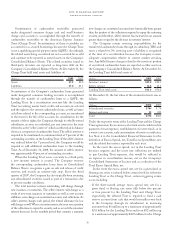American Express 2008 Annual Report Download - page 47
Download and view the complete annual report
Please find page 47 of the 2008 American Express annual report below. You can navigate through the pages in the report by either clicking on the pages listed below, or by using the keyword search tool below to find specific information within the annual report.2008 financial review
american express company
it. Derivative financial instruments, primarily interest rate
swaps, with notional amounts of approximately $18.0 billion
were outstanding at December 31, 2008 and 2007. These
derivatives generally qualify for hedge accounting. A portion of
these derivatives outstanding as of December 31, 2008, extend
to 2018. The Company does not engage in derivative financial
instruments for trading purposes.
The detrimental effect on the Company’s pretax earnings
of a hypothetical 100 basis point increase in interest rates
would be approximately $152 million ($112 million related to
the U.S. dollar), based on the 2008 year-end positions. This
effect, which is calculated using a static asset liability gapping
model, is primarily determined by the volume of variable rate
funding of charge card and fixed-rate lending products for
which the interest rate exposure is not managed by derivative
financial instruments. As of year end 2008, the percentage of
total worldwide managed loans that were deemed to be fixed-
rate was 36 percent, with the remaining 64 percent deemed to
be variable rate.
Foreign exchange risk is generated by cardmember cross-
currency charges, foreign currency denominated balance sheet
exposures, translation exposure of foreign operations, and
foreign currency earnings in international units. The Company’s
foreign exchange risk is managed primarily by entering into
agreements to buy and sell currencies on a spot basis or by
hedging this market exposure to the extent it is economically
justified through various means, including the use of derivative
financial instruments such as foreign exchange forward, options,
and cross-currency swap contracts, which can help “lock in” the
value of the Company’s exposure to specific currencies.
At December 31, 2008 and 2007, foreign currency products
with total notional amounts of approximately $17 billion
and $14 billion, respectively, were outstanding. Derivative
hedging activities related to cross-currency charges, balance
sheet exposures, and foreign currency earnings generally do
not qualify for hedge accounting; however, derivative hedging
activities related to translation exposure of foreign operations
generally do.
With respect to cross-currency charges and balance
sheet exposures, including related foreign exchange forward
contracts outstanding, the effect on the Company’s earnings
of a hypothetical 10 percent change in the value of the U.S.
dollar would be immaterial as of December 31, 2008. With
respect to foreign currency earnings, the adverse impact on
pretax income of a 10 percent strengthening of the U.S. dollar
related to anticipated overseas operating results for the next
12 months, including any related foreign exchange forward
contracts entered into in January 2009, would hypothetically
be $105 million as of December 31, 2008. With respect to
translation exposure of foreign operations, including related
foreign exchange forward contracts outstanding, a 10 percent
strengthening in the U.S. dollar would result in an immaterial
reduction in equity as of December 31, 2008.
The actual impact of interest rate and foreign exchange rate
changes will depend on, among other factors, the timing of rate
changes, the extent to which different rates do not move in the
same direction or in the same direction to the same degree, and
changes in the volume and mix of the Company’s businesses.
For example, the Company is also subject to market risk from
changes in the relationship between the benchmark prime rate
that determines the yield on its variable-rate lending receivables
and the benchmark LIBOR rate that determines the effective
interest cost on a significant portion of its outstanding debt,
including asset securitizations. Simultaneous and identically-
sized changes in the same direction of these two indices do not
contribute to the market risk described above, as there is no
material mismatch in the effective repricing frequency of these
two indices. However, differences in the rate of change of these
two indices, commonly referred to as basis risk, will impact the
Company’s variable-rate U.S. lending net interest margin. The
Company currently has approximately $44.6 billion of prime-
based, variable-rate U.S. lending receivables that are funded
with LIBOR-indexed debt, including asset securitizations.
Historically, the spread between 1 month LIBOR and the
federal funds rate has averaged 20 basis points. During the
fourth quarter of 2008, this spread was as high as approximately
300 basis points, although it has subsequently declined from
those levels.
liquidity risk management process
Liquidity risk is defined as the inability to access cash and
equivalents needed to meet business requirements and satisfy
the Company’s obligations. General principles and the overall
framework for managing liquidity risk across the Company are
defined in the Liquidity Risk Policy approved by the ERMC.
The Company balances the trade-offs between maintaining too
much liquidity, which can be costly and limit financial flexibility,
with having inadequate liquidity, which may result in financial
distress during a liquidity event. Liquidity risk is centrally
managed by the Funding and Liquidity Committee, chaired
by the Corporate Treasurer. The Company has developed a
liquidity plan that enables it to meet its daily cash obligations
when access to both unsecured and secured funds in the debt
capital markets is impaired or unavailable. This plan is designed
to ensure that the Company and all of its main operating
entities could continuously maintain business operations for
a 12-month period in which its access to all capital markets
financing is interrupted. The hypothetical 12-month liquidity
crisis is assumed to occur as a sudden and unexpected event that
temporarily impairs access to or makes unavailable financing in
the unsecured debt capital markets.
45
























